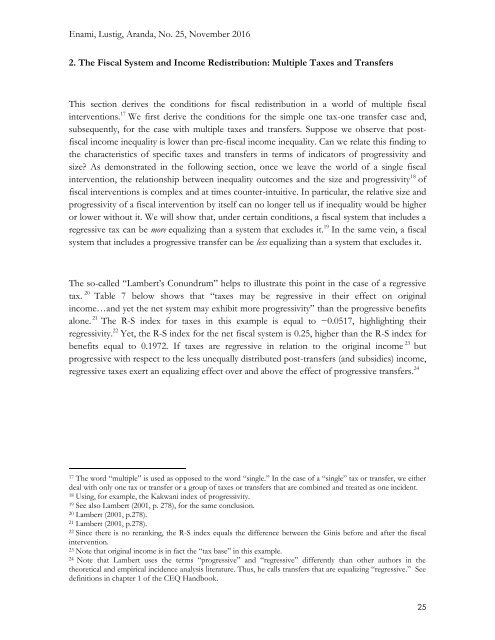IMPACT OF TAXES AND TRANSFERS
n?u=RePEc:tul:ceqwps:25&r=lam
n?u=RePEc:tul:ceqwps:25&r=lam
You also want an ePaper? Increase the reach of your titles
YUMPU automatically turns print PDFs into web optimized ePapers that Google loves.
Enami, Lustig, Aranda, No. 25, November 2016<br />
2. The Fiscal System and Income Redistribution: Multiple Taxes and Transfers<br />
This section derives the conditions for fiscal redistribution in a world of multiple fiscal<br />
interventions. 17 We first derive the conditions for the simple one tax-one transfer case and,<br />
subsequently, for the case with multiple taxes and transfers. Suppose we observe that postfiscal<br />
income inequality is lower than pre-fiscal income inequality. Can we relate this finding to<br />
the characteristics of specific taxes and transfers in terms of indicators of progressivity and<br />
size? As demonstrated in the following section, once we leave the world of a single fiscal<br />
intervention, the relationship between inequality outcomes and the size and progressivity 18 of<br />
fiscal interventions is complex and at times counter-intuitive. In particular, the relative size and<br />
progressivity of a fiscal intervention by itself can no longer tell us if inequality would be higher<br />
or lower without it. We will show that, under certain conditions, a fiscal system that includes a<br />
regressive tax can be more equalizing than a system that excludes it. 19 In the same vein, a fiscal<br />
system that includes a progressive transfer can be less equalizing than a system that excludes it.<br />
The so-called “Lambert’s Conundrum” helps to illustrate this point in the case of a regressive<br />
tax. 20 Table 7 below shows that “taxes may be regressive in their effect on original<br />
income…and yet the net system may exhibit more progressivity” than the progressive benefits<br />
alone. 21 The R-S index for taxes in this example is equal to −0.0517, highlighting their<br />
regressivity. 22 Yet, the R-S index for the net fiscal system is 0.25, higher than the R-S index for<br />
benefits equal to 0.1972. If taxes are regressive in relation to the original income 23 but<br />
progressive with respect to the less unequally distributed post-transfers (and subsidies) income,<br />
regressive taxes exert an equalizing effect over and above the effect of progressive transfers. 24<br />
17 The word “multiple” is used as opposed to the word “single.” In the case of a “single” tax or transfer, we either<br />
deal with only one tax or transfer or a group of taxes or transfers that are combined and treated as one incident.<br />
18 Using, for example, the Kakwani index of progressivity.<br />
19 See also Lambert (2001, p. 278), for the same conclusion.<br />
20 Lambert (2001, p.278).<br />
21 Lambert (2001, p.278).<br />
22 Since there is no reranking, the R-S index equals the difference between the Ginis before and after the fiscal<br />
intervention.<br />
23 Note that original income is in fact the “tax base” in this example.<br />
24 Note that Lambert uses the terms “progressive” and “regressive” differently than other authors in the<br />
theoretical and empirical incidence analysis literature. Thus, he calls transfers that are equalizing “regressive.” See<br />
definitions in chapter 1 of the CEQ Handbook.<br />
25



